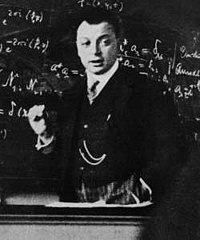
Wolfgang Pauli
https://en.m.wikipedia.org/wiki/Pauli_exclusion_principle#
The Pauli exclusion principle is the quantum mechanical principle which states that two or more identical fermions (particles with half-integer spin) cannot occupy the same quantum state within a quantum system simultaneously.
In the case of electrons in atoms, it can be stated as follows:
it is impossible for two electrons of a poly-electron atom to have the same values of the four quantum numbers: n, the principal quantum number, ℓ, the angular momentum quantum number, mℓ, the magnetic quantum number, and ms, the spin quantum number.
For example, if two electrons reside in the same orbital, and if their n, ℓ, and mℓ values are the same, then their ms must be different, and thus the electrons must have opposite half-integer spins of 1/2 and −1/2.
This principle was formulated by Austrian physicist Wolfgang Pauli in 1925 for electrons, and later extended to all fermions with his spin-statistics theorem of 1940.
A more rigorous statement is that the total wave function for two identical fermions is antisymmetric with respect to exchange of the particles.
This means that the wave function changes its sign if the space and spin co-ordinates of any two particles are interchanged.
Particles with an integer spin, or bosons, are not subject to the Pauli exclusion principle: any number of identical bosons can occupy the same quantum state, as with, for instance, photons produced by a laser and Bose–Einstein condensate.
Particles with an integer spin, or bosons, are not subject to the Pauli exclusion principle: any number of identical bosons can occupy the same quantum state, as with, for instance, photons produced by a laser and Bose–Einstein condensate.
ReplyDelete